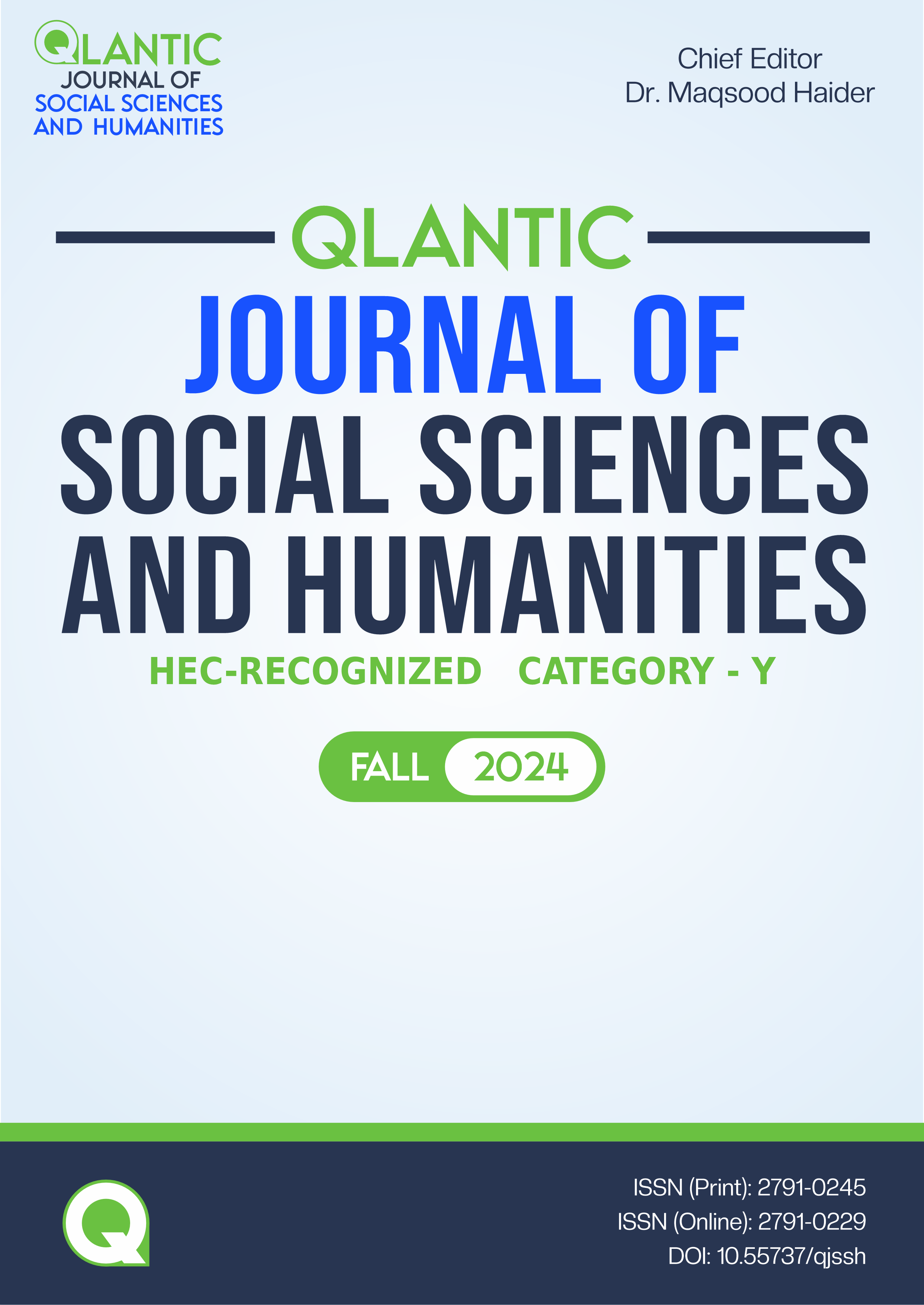Mediating Role of Cognitive Flexibility in the Relationship between Smartphone Addiction and Phubbing
DOI:
https://doi.org/10.55737/qjssh.v-iv(CP).24273Keywords:
Smartphone addiction, phubbing, cognitive flexibility , digital wellbeingAbstract
The widespread adoption of smartphones raised worries about addictive behaviours, especially smartphone addiction and phubbing. Contrary to prior research, the study aimed to investigate, phubbing as predictor of smartphone addiction, and determining the mediating role of cognitive flexibility in the association between phubbing and smartphone addiction. A cross-sectional survey was conducted among 255 participants (42% males, 58% females), aged 18 to 30 years. Data were collected using the Generic Scale of Phubbing (GSP) to measure phubbing, the Smartphone Addiction Scale-Short Version (SAS-SV) to assess smartphone addiction, and A New Measure of Cognitive Flexibility to evaluate cognitive flexibility. The findings showed a negative correlation between phubbing and cognitive flexibility and a positive correlation between higher levels of phubbing and increased smartphone addiction. The association between phubbing and an addiction to smartphones is partially mediated by cognitive flexibility, according to mediation analysis. Furthermore, there were no gender differences in cognitive flexibility or smartphone addiction, but there were notable gender differences in phubbing action, with men scoring higher than women. This study emphasizes the mediation impact of cognitive flexibility and the crucial importance of phubbing as predictor of smartphone addiction. Enhancing cognitive flexibility through interventions could be a useful strategy for reducing smartphone addiction and fostering young people's digital well-being.
References
Alexopoulou, A., Batsou, A., & Drigas, A. (2020). Mobiles and Cognition: The Associations Between Mobile Technology and Cognitive Flexibility. International Journal of Interactive Mobile Technologies (IJIM), 14(03), 146. https://doi.org/10.3991/ijim.v14i03.11233
Alqaderi, N., Banibella, A., Abdelmonem, K. Y. A., Teir, H. J., & Andrade, G. (2023). Phone addiction, cyberbullying, and mental health amongst young adults in the United Arab Emirates: a cross-sectional study. BMC Psychology, 11(1). https://doi.org/10.1186/s40359-023-01320-1
Al‐Saggaf, Y., & O’Donnell, S. B. (2019). Phubbing: Perceptions, reasons behind, predictors, and impacts. Human Behavior and Emerging Technologies, 1(2), 132–140. https://doi.org/10.1002/hbe2.137
Al-Saggaf, Y., MacCulloch, R., & Wiener, K. (2018). Trait Boredom Is a Predictor of Phubbing Frequency. Journal of Technology in Behavioral Science, 4(3), 245–252. https://doi.org/10.1007/s41347-018-0080-4
American Psychiatric Association. (2013). Diagnostic and statistical manual of mental disorders: DSM-5 (5th edition). American Psychiatric Publishing, 5(5).
Anshari, M., Alas, Y., Hardaker, G., Jaidin, J. H., Smith, M., & Ahad, A. D. (2016). Smartphone habit and behavior in Brunei: Personalization, gender, and generation gap. Computers in Human Behavior, 64, 719–727. https://doi.org/10.1016/j.chb.2016.07.063
Aygar, H., Tozun, M., Unsal, A., Arslantas, D., Oktar, D., & Dagtekin, G. (2021). Determination of the prevalence of phubbing and its possible relations with personality characteristics and with the other factors among the students of the faculty of medicine from western Turkey. International Research Journal of Social Sciences, 10(1), 20-27.
Backlinko Team. (2024, March 11). Revealing Average Screen Time Statistics for 2024. Backlinko. https://backlinko.com/screen-time-statistics
Badre, D., & Wagner, A. D. (2006). Computational and neurobiological mechanisms underlying cognitive flexibility. Proceedings of the National Academy of Sciences, 103(18), 7186–7191. https://doi.org/10.1073/pnas.0509550103
Bağatarhan, T., & Siyez, D. M. (2022). The Effectiveness of a Cognitive-Behavioral Prevention Program for Internet Addiction. Journal of Rational-Emotive & Cognitive-Behavior Therapy. https://doi.org/10.1007/s10942-021-00439-7
Bajwa, R. S., Abdullah, H., Zaremohzzabieh, Z., Wan Jaafar, W. M., & Abu Samah, A. (2023). Smartphone addiction and phubbing behavior among university students: A moderated mediation model by fear of missing out, social comparison, and loneliness. Frontiers in Psychology, 13. https://doi.org/10.3389/fpsyg.2022.1072551
Bala, S., Tekkam, S., & Pandve, H. (2020). Consequence of phubbing on psychological distress among the youth of Hyderabad. Medical Journal of Dr. D.Y. Patil Vidyapeeth, 13(6), 642. https://doi.org/10.4103/mjdrdypu.mjdrdypu_315_19
Braem, S., & Egner, T. (2018). Getting a Grip on Cognitive Flexibility. Current Directions in Psychological Science, 27(6), 470–476. https://doi.org/10.1177/0963721418787475
Bulut, S., & Nazir, T. (2020). Phubbing Phenomenon: A Wild Fire, Which Invades Our Social Communication and Life. Open Journal of Medical Psychology, 09(01), 1–6. https://doi.org/10.4236/ojmp.2020.91001
Canas, J. J., Fajardo, I., & Salmeron, L. (2006). Cognitive flexibility. International encyclopedia of ergonomics and human factors, 1(3), 297-301.
Cassidy, A. R. (2020). Cognitive flexibility in critical CHD: a target for intervention. Cardiology in the Young, 30(8), 1061–1069. https://doi.org/10.1017/s1047951120001870
Cetin, H., Turkmen, C., Bal, G. A., Tekerlek, H., Bilgin, S., & Köse, N. (2022). Factors affecting the performance of the deep cervical flexors in young people using smartphones. CRANIO®, 1–9. https://doi.org/10.1080/08869634.2022.2078944
Chatterjee, S. (2020). Antecedents of phubbing: from technological and psychological perspectives. Journal of Systems and Information Technology, 22(2), 161–178. https://doi.org/10.1108/jsit-05-2019-0089
Chen, C., Zhang, K. Z. K., Gong, X., Zhao, S. J., Lee, M. K. O., & Liang, L. (2017). Examining the effects of motives and gender differences on smartphone addiction. Computers in Human Behavior, 75, 891–902. https://doi.org/10.1016/j.chb.2017.07.002
Chen, Y., Yu, Y., & Zhu, K. (2023). Analysis of Smartphone Addiction Today: A Literature Review. Journal of Education, Humanities and Social Sciences, 8, 921–927. https://doi.org/10.54097/ehss.v8i.4382
Choi, M.-Y., & Kim, J.-S. (2016). Influence of Cell Phone Addiction on Communication Skills and Interpersonal Relationship Ability of Adolescents. Journal of the Korean Society of School Health, 29(3), 149–155. https://doi.org/10.15434/kssh.2016.29.3.149
Chotpitayasunondh, V., & Douglas, K. M. (2016). How “phubbing” becomes the norm: The antecedents and consequences of snubbing via smartphone. Computers in Human Behavior, 63, 9–18. https://doi.org/10.1016/j.chb.2016.05.018
Chotpitayasunondh, V., & Douglas, K. M. (2018). The effects of “phubbing” on social interaction. Journal of Applied Social Psychology, 48(6), 304–316. https://doi.org/10.1111/jasp.12506
Ciairano, S., Bonino, S., & Miceli, R. (2006). Cognitive flexibility and social competence from childhood to early adolescence. Cognitie, Creier, Comportament/Cognition, Brain, Behavior, 10(3).
Da Silva, S. (2023). System 1 vs. System 2 Thinking. Psych, 5(4), 1057–1076. https://doi.org/10.3390/psych5040071
Dajani, D. R., & Uddin, L. Q. (2015). Demystifying cognitive flexibility: Implications for clinical and developmental neuroscience. Trends in Neurosciences, 38(9), 571–578. https://doi.org/10.1016/j.tins.2015.07.003
Demirtas, A. S. (2020). Hopelessness and perceived stress: the mediating role of cognitive flexibility and intolerance of uncertainty. Dusunen Adam: The Journal of Psychiatry and Neurological Sciences. https://doi.org/10.14744/dajpns.2019.00035
Diamond, A. (2013). Executive Functions. Annual Review of Psychology, 64(1), 135–168. https://doi.org/10.1146/annurev-psych-113011-143750
Duradoni, M., Raimondi, T., Buttà, F., & Guazzini, A. (2023). Moving beyond an Addiction Framework for Phubbing: Unraveling the Influence of Intrinsic Motivation, Boredom, and Online Vigilance. Human Behavior and Emerging Technologies, 2023, e6653652. https://doi.org/10.1155/2023/6653652
Elhai, J. D., Dvorak, R. D., Levine, J. C., & Hall, B. J. (2017). Problematic smartphone use: A conceptual overview and systematic review of relations with anxiety and depression psychopathology. Journal of Affective Disorders, 207(207), 251–259. https://doi.org/10.1016/j.jad.2016.08.030
Erzen, E., Odaci, H., & Yeniçeri, İ. (2019). Phubbing: Which Personality Traits Are Prone to Phubbing? Social Science Computer Review, 39(1), 089443931984741. https://doi.org/10.1177/0894439319847415
Escalera -Chávez, M. E., García-Santillán, A., & Molchanova, V. S. (2020). Phubbing Behavior: Is There a Gender Difference in College Students?. European Journal of Contemporary Education, 9(3), 546-551. https://doi.org/10.13187/ejced.2020.3.546
Evans, J. St. B. T., & Stanovich, K. E. (2013). Dual-Process Theories of Higher Cognition. Perspectives on Psychological Science, 8(3), 223–241. https://doi.org/10.1177/1745691612460685
Gao, T., Xiang, Y.-T., Zhang, H., Zhang, Z., & Mei, S. (2017). Neuroticism and quality of life: Multiple mediating effects of smartphone addiction and depression. Psychiatry Research, 258, 457–461. https://doi.org/10.1016/j.psychres.2017.08.074
Geng, J., Lei, L., Ouyang, M., Nie, J., & Wang, P. (2021). The influence of perceived parental phubbing on adolescents’ problematic smartphone use: A two-wave multiple mediation model. Addictive Behaviors, 121, 106995. https://doi.org/10.1016/j.addbeh.2021.106995
Gladden, D. (2018). The Effects of Smartphones on Social Lives: How They Affect Our Social Interactions and Attitudes. OTS Master’s Level Projects & Papers. https://digitalcommons.odu.edu/ots_masters_projects/586
Gladys, & Villalón-Hernández, R. (2023). Estudio de la prevalencia del phubbing durante clases ocasionado por el uso de apps. Alteridad : Revista de Educación, 18(1), 59–69. https://doi.org/10.17163/alt.v18n1.2023.05
Guazzini, A., Duradoni, M., Capelli, A., & Meringolo, P. (2019). An Explorative Model to Assess Individuals’ Phubbing Risk. Future Internet, 11(1), 21. https://doi.org/10.3390/fi11010021
Hadlington, L. J. (2015). Cognitive failures in daily life: Exploring the link with Internet addiction and problematic mobile phone use. Computers in Human Behavior, 51, 75–81. https://doi.org/10.1016/j.chb.2015.04.036
Han, S.-G., & Kim, D.-T. (2019). 스마트폰 중독 청소년의 중독원인에 대한 현상학적 분석 한상규 1* , 김동태 2 1 영남이공대학교 교양과 외래교수, 2 영남신학대학교 신학과 외래교수 Phenomenological Analysis on Causes of Addiction in Smartphone Addiction Adolescents. https://doi.org/10.15207/JKCS.2019.10.5.287
Herrero, J., Urueña, A., Torres, A., & Hidalgo, A. (2017). Smartphone addiction: psychosocial correlates, risky attitudes, and smartphone harm. Journal of Risk Research, 22(1), 81–92. https://doi.org/10.1080/13669877.2017.1351472
Howarth, J. (January 26, 2023). How Many Individuals Use Smartphones? More than 80 Smartphone Statistics. Exploding Subjects. Smartphone Statistics: https://explodingtopics.com/blog/
Ionescu, T. (2012). Exploring the nature of cognitive flexibility. New Ideas in Psychology, 30(2), 190–200. https://doi.org/10.1016/j.newideapsych.2011.11.001
James, R. J. E., Dixon, G., Dragomir, M.-G., Thirlwell, E., & Hitcham, L. (2023). Understanding the construction of “behavior” in smartphone addiction: A scoping review. Addictive Behaviors, 137, 107503. https://doi.org/10.1016/j.addbeh.2022.107503
Jan, A., & Li, E. Y. (2024). What you see isn’t what it is: Understanding the impact of smartphones on interpersonal connections. AIS Electronic Library (AISeL). https://aisel.aisnet.org/iceb2024/16/
Johnco, C., Wuthrich, V. M., & Rapee, R. M. (2014). The influence of cognitive flexibility on treatment outcome and cognitive restructuring skill acquisition during cognitive behavioural treatment for anxiety and depression in older adults: Results of a pilot study. Behaviour Research and Therapy, 57(57), 55–64. https://doi.org/10.1016/j.brat.2014.04.005
Kemp, S. (2023, February 13). Digital 2023: Pakistan. DataReportal – Global Digital Insights. https://datareportal.com/reports/digital-2023-pakistan
Khalily, M., Loona, M., Bhatti, M., Ahmad, I., & Saleem, T. (2020). Smartphone addiction and its associated factors among students in twin cities of Pakistan. Journal of the Pakistan Medical Association, 0, 1. https://doi.org/10.5455/jpma.23054
Kim, C., Johnson, N. F., Cilles, S. E., & Gold, B. T. (2011). Common and Distinct Mechanisms of Cognitive Flexibility in Prefrontal Cortex. Journal of Neuroscience, 31(13), 4771–4779. https://doi.org/10.1523/jneurosci.5923-10.2011
Kim, J.-H. (2021). Factors Associated with Smartphone Addiction Tendency in Korean Adolescents. International Journal of Environmental Research and Public Health, 18(21), 11668. https://doi.org/10.3390/ijerph182111668
Kim, S.-G., Park, J., Kim, H.-T., Pan, Z., Lee, Y., & McIntyre, R. S. (2019). The relationship between smartphone addiction and symptoms of depression, anxiety, and attention-deficit/hyperactivity in South Korean adolescents. Annals of General Psychiatry, 18(1). https://doi.org/10.1186/s12991
Kim, Y., Jeong, J.-E., Cho, H., Jung, D.-J., Kwak, M., Rho, M. J., Yu, H., Kim, D.-J., & Choi, I. Y. (2016). Personality Factors Predicting Smartphone Addiction Predisposition: Behavioral Inhibition and Activation Systems, Impulsivity, and Self-Control. PLOS ONE, 11(8), e0159788. https://doi.org/10.1371/journal.pone.0159788
Koesten, J., Schrodt, P., & Ford, D. J. (2009). Cognitive Flexibility as a Mediator of Family Communication Environments and Young Adults’ Well-Being. Health Communication, 24(1), 82–94. https://doi.org/10.1080/10410230802607024
Kuss, D., & Griffiths, M. (2017). Social Networking Sites and Addiction: Ten Lessons Learned. International Journal of Environmental Research and Public Health, 14(3), 311. https://doi.org/10.3390/ijerph14030311
Latifa, R., Mumtaz, E. F., & Subchi, I. (2019, November 1). Psychological Explanation of Phubbing Behavior: Smartphone Addiction, Emphaty and Self Control. IEEE Xplore. https://doi.org/10.1109/CITSM47753.2019.8965376
Leuppert, R., & Geber, S. (2020). Commonly done but not socially accepted? Phubbing and social norms in dyadic and small group settings. Communication Research Reports, 37(3), 55–64. https://doi.org/10.1080/08824096.2020.1756767
Li, G.-R., Sun, J., Ye, J.-N., Hou, X.-H., & Xiang, M.-Q. (2023). Family functioning and mobile phone addiction in university students: Mediating effect of loneliness and moderating effect of capacity to be alone. Frontiers in Psychology, 14. https://doi.org/10.3389/fpsyg.2023.1076852
Li, L., Niu, Z., Mei, S., & Griffiths, M. D. (2021). A network analysis approach to the relationship between fear of missing out (FoMO), smartphone addiction, and social networking site use among a sample of Chinese university students. Computers in Human Behavior, 128, 107086. https://doi.org/10.1016/j.chb.2021.107086
Li, Y.-X., Zhang, Y.-H., Yang, R., Lian, S.-L., Yan, L., & Zhu, X.-M. (2021). Relationship Between Perceived Social Norms and Phubbing: Individual Control and Fear of Missing Out as Mediators. International Journal of Mental Health and Addiction. https://doi.org/10.1007/s11469-021-00696-8
Lian, S.-L., Cao, X.-D., Xiao, Q., Lee, S., Yang, C., & Liu, Q. (2023). Family cohesion and adaptability reduces mobile phone addiction: the mediating and moderating roles of automatic thoughts and peer attachment. Frontiers in Psychology, 14. https://doi.org/10.3389/fpsyg.2023.1122943
Lin, W.-L., Tsai, P.-H., Lin, H.-Y., & Chen, H.-C. (2013). How does emotion influence different creative performances? The mediating role of cognitive flexibility. Cognition and Emotion, 28(5), 834–844. https://doi.org/10.1080/02699931.2013.854195
Lin, Y.-H., Chiang, C.-L., Lin, P.-H., Chang, L.-R., Ko, C.-H., Lee, Y.-H., & Lin, S.-H. (2016). Proposed Diagnostic Criteria for Smartphone Addiction. PLOS ONE, 11(11), e0163010. https://doi.org/10.1371/journal.pone.0163010
Mackay, J. (2019, April 5). Screen time stats 2018: How your phone impacts your workday – RescueTime. RescueTime Blog. https://blog.rescuetime.com/screen-time-stats-2018/
Martin, M. M., & Anderson, C. M. (1998). The cognitive flexibility scale: Three validity studies. Communication Reports, 11(1), 1–9. https://doi.org/10.1080/08934219809367680
Martin, M. M., & Rubin, R. B. (1995). A New Measure of Cognitive Flexibility. Psychological Reports, 76(2), 623–626. https://doi.org/10.2466/pr0.1995.76.2.623
Masley, S., Roetzheim, R., & Gualtieri, T. (2009). Aerobic Exercise Enhances Cognitive Flexibility. Journal of Clinical Psychology in Medical Settings, 16(2), 186–193. https://doi.org/10.1007/s10880-009-9159-6
Moore, A., & Malinowski, P. (2009). Meditation, Mindfulness and Cognitive Flexibility. Consciousness and Cognition, 18(1), 176–186. https://doi.org/10.1016/j.concog.2008.12.008
Mutchler, L., Shim, J. P., & Ormond, D. (2011). Exploratory Study on Users’ Behavior: Smartphone Usage. AMCIS 2011 Proceedings - All Submissions. https://aisel.aisnet.org/amcis2011_submissions/418/
Nagarajappa, R., Naik, D., & Ramesh, G. (2020). Emerging Consequences of Phubbing among Adults. Indian Journal of Forensic Medicine & Toxicology, 14(4). https://doi.org/10.37506/ijfmt.v14i4.12936
Nazir, T., & Bulut, S. (2019). Phubbing: a phenomenon that is mending social relationships. Сибирский психологический журнал, (74), 101-109. https://cyberleninka.ru/article/n/phubbing-a-phenomenon-that-is-mending-social-relationships
Neisser, U., & Becklen, R. (1975). Selective looking: Attending to visually specified events. Cognitive Psychology, 7(4), 480–494. https://doi.org/10.1016/0010-0285(75)90019-5
Nie, N. H. (2001). Sociability, Interpersonal Relations, and the Internet. American Behavioral Scientist, 45(3), 420–435. https://doi.org/10.1177/00027640121957277
Ozcan, B., & Acimis, N. M. (2021). Sleep Quality in Pamukkale University Students and its relationship with smartphone addiction. Pakistan Journal of Medical Sciences, 37(1), 206–211. https://doi.org/10.12669/pjms.37.1.3130
Parasuraman, S., Sam, A., Yee, S. K., Chuon, B. C., & Ren, L. (2017). Smartphone usage and increased risk of mobile phone addiction: A concurrent study. International Journal of Pharmaceutical Investigation, 7(3), 125. https://doi.org/10.4103/jphi.jphi_56_17
Parmaksız, İ., & Kılıçarslan, S. (2021). AGGRESSION AND EMOTIONAL INTELLIGENCE AS PREDICTORS OF PHUBBING. Psycho-Educational Research Reviews. https://doi.org/10.52963/perr_biruni_v10.n3.12
Peleg, O., & Boniel-Nissim, M. (2024). Exploring the personality and relationship factors that mediate the connection between differentiation of self and phubbing. Scientific Reports, 14(1). https://doi.org/10.1038/s41598-024-55560-1
Peleg, O., & Boniel-Nissim, M. (2024). Exploring the personality and relationship factors that mediate the connection between differentiation of self and phubbing. Scientific Reports, 14(1). https://doi.org/10.1038/s41598-024-55560-1
Rahman, M. A., Duradoni, M., & Guazzini, A. (2021). Identification and prediction of phubbing behavior: a data-driven approach. Neural Computing and Applications, 34(5), 3885–3894. https://doi.org/10.1007/s00521-021-06649-5
Roberts, J., Yaya, L., & Manolis, C. (2014). The invisible addiction: Cell-phone activities and addiction among male and female college students. Journal of Behavioral Addictions, 3(4), 254–265. https://doi.org/10.1556/jba.3.2014.015
Sansevere, K. S., & Ward, N. (2021). Linking Phubbing Behavior to Self-Reported Attentional Failures and Media Multitasking. Future Internet, 13(4), 100. https://doi.org/10.3390/fi13040100
Schneider, F. M., & Hitzfeld, S. (2019). I ought to put down that phone but I phub nevertheless: Examining the predictors of phubbing behavior. Social Science Computer Review, 39(6), 089443931988236. https://doi.org/10.1177/0894439319882365
Stevens, A. D. (2009). Social problem-solving and cognitive flexibility: Relations to social skills and problem behavior of at-risk young children. Seattle Pacific University.
Sun, J., & Samp, J. A. (2021). “Phubbing is happening to you”: examining predictors and effects of phubbing behaviour in friendships. Behaviour & Information Technology, 41(12), 1–14. https://doi.org/10.1080/0144929x.2021.1943711
Tanhan, F., Özok, H. İ., Kaya, A., & Yıldırım, M. (2023). Mediating and moderating effects of cognitive flexibility in the relationship between social media addiction and phubbing. Current Psychology. https://doi.org/10.1007/s12144-023-04242-8
Themanson, J. R., Pontifex, M. B., & Hillman, C. H. (2008). Fitness and action monitoring: Evidence for improved cognitive flexibility in young adults. Neuroscience, 157(2), 319–328. https://doi.org/10.1016/j.neuroscience.2008.09.014
Tran, D. (2016). Classifying Nomophobia as Smart-Phone Addiction Disorder. UC Merced Undergraduate Research Journal, 9(1). https://doi.org/10.5070/m491033274
Wang, Q., Chen, H., Hu, W., & Zhao, F. (2023). Social networking sites addiction and depression among Chinese college students: The mediating role of cognitive flexibility and the moderating role of chronotype. Children and Youth Services Review, 155, 107209–107209. https://doi.org/10.1016/j.childyouth.2023.107209
Yang, G., Li, Y., Liu, S., Liu, C., Jia, C., & Wang, S. (2021). Physical activity influences the mobile phone addiction among Chinese undergraduates: The moderating effect of exercise type. Journal of Behavioral Addictions. https://doi.org/10.1556/2006.2021.00059
Yang, J., Fu, X., Liao, X., & Li, Y. (2019). Association of problematic smartphone use with poor sleep quality, depression, and anxiety: A systematic review and meta-analysis. Psychiatry Research, 284, 112686. https://doi.org/10.1016/j.psychres.2019.112686
Yang, K.-M. (2016). The Effect of Self-Esteem and Depression on Smartphone Addiction among University Students. Journal of the Korea Convergence Society, 7(1), 113–123. https://doi.org/10.15207/JKCS.2016.7.1.113
Yoo, I.-G., & Do, J.-H. (2022). Exploring the link between smartphone overuse and cognitive decline: a scoping review. Family Medicine & Primary Care Review, 24(1), 92–99. https://doi.org/10.5114/fmpcr.2022.113022
Yu, S., & Sussman, S. (2020). Does Smartphone Addiction Fall on a Continuum of Addictive Behaviors? International Journal of Environmental Research and Public Health, 17(2), 422. https://doi.org/10.3390/ijerph17020422
Zhang, K., Lu, X., Zhang, X., Zhang, J., Ren, J., Guo, H., Zhu, Z., Yang, H., Yuan, G., Jin, G., Du, J., Shi, H., Hao, J., Sun, Y., Su, P., Yang, L., & Zhang, Z. (2023). Effects of Psychological or Exercise Interventions on Problematic Mobile Phone Use: a Systematic Review and Meta-analysis. Current Addiction Reports, 10(2), 230–253. https://doi.org/10.1007/s40429-023-00471-w
Downloads
Published
Issue
Section
License
Copyright (c) 2024 Sana Abdul Qayyum, Dr. Asma Sikandar, Dr. Syeda Tafseer Zahra

This work is licensed under a Creative Commons Attribution-NonCommercial 4.0 International License.





